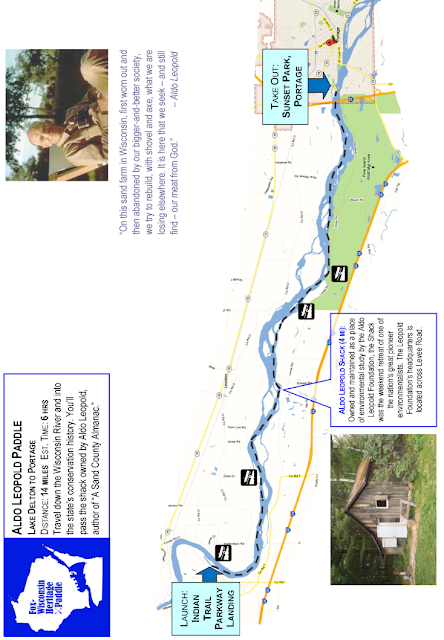SPRING GREEN, Wis. -- A tree fell in the forest and we happened to be nearby. I can state conclusively, it made a sound. A big sound.
It happened on day two of the first Fox-Wisconsin Heritage Paddle of the season. The previous morning, Friday, May 18, we had launched from Wisconsin Riverside Campground in Spring Green and paddled to Gotham. (Say it like Go-thum, not like the New York nickname, if you want to sound like a native.)
We were 10 people and two dogs in eight boats -- mostly kayaks and a few canoes.
The dogs were a 3-year-old yellow Lab named Sophie and a 6-month-old golden retriever named Savanna. Both were incredibly content in their humans' canoes, though Sophie let it be known with a whimper when it was time to beach at a sandbar to take care of business. Savanna's challenge was containing her exuberance for meeting new people at the landings.
This is the third year for the Fox-Wisconsin Heritage Paddle. While we have added a way for likely participants to notify us from our website (www.wisconsinpaddlers.org), we never know how many will show up until we get to the landing.
Ten was the smallest turnout to date, but this was the first Friday daytime paddle. We traveled 13 miles through the beauty that is the lower Wisconsin River. This section is part of a state scenic area that limits development and requires that buildings not be visible from the river when trees are fully leafed out.
You are left with thick woods and towering bluffs as the backdrop for your paddling.
That brings us to Saturday. Our numbers had grown to 18 people in 15 boats -- and still two dogs – for the 13 miles from where we left off at the Buena Vista boat landing in Gotham to Blue River.
The wind was blowing stronger than the day before and was living up to the paddlers' truism: "If the wind is in your face, you know you're going the right direction."
We came to a spot in the river where the woods seemed to funnel the wind. We heard a loud crack, a pause and a series of louder cracks. We looked river left to see what must have been a 40-foot hardwood collapse into chunks and drop to the forest floor.
It reminded me -- small scale -- of ice calving off the face of a glacier.
What are the odds? We were in just the right spot at just the right time in a five-hour paddle to see this lone tree near the shoreline give up its well-rotted remains.
It was a highlight of the weekend, though one we couldn't savor too much for too long. We had miles to go and a stiff wind in our faces.
As we approached our 26th mile in two days, even strong paddlers at the front of the group were hoping the next bend in the river would bring into view the bridge that marked the take-out at the Port Andrew boat landing in Blue River.
It had been two full days of paddling, separated by a long evening of new friendships forming around the campfire.
Sunday, feeling like the slightest suggestion from anyone would have sent us on our nearly three-hour drive home, we instead took time for a leisurely paddle with a small group. We went to Long Lake, a narrow two miles or so river left behind when the Wisconsin had carved out a new course years ago.
It was easily worth the delay and only geared us up for the next Fox-Wisconsin Heritage Paddle 2012 event -- June 9-10, the Eco-Heritage Paddles, in the Wisconsin and Fox rivers near Portage. (Details at www.wisconsinpaddlers.org.)
 • We have one more eagle than we might have. When an adult bald eagle flew into the grille of Brian Baker’s pickup truck as he traveled down State 10 in Weyauwega last June, it seemed the bird had no chance. Baker called the sheriff’s department, which called DNR warden Ted Dremel, who gingerly pulled the eagle’s head from the plastic shards of the grille. New London bird rehabber Pat Fisher and vet Jim Ziegler nursed the eagle back to health and, a month later, I was able to watch it leave Ziegler’s gloved hands and fly back into nature. The story was picked up by CNN and a picture Baker snapped with his phone made the DNR’s top 10 list of wildlife photos for the year.
• We have one more eagle than we might have. When an adult bald eagle flew into the grille of Brian Baker’s pickup truck as he traveled down State 10 in Weyauwega last June, it seemed the bird had no chance. Baker called the sheriff’s department, which called DNR warden Ted Dremel, who gingerly pulled the eagle’s head from the plastic shards of the grille. New London bird rehabber Pat Fisher and vet Jim Ziegler nursed the eagle back to health and, a month later, I was able to watch it leave Ziegler’s gloved hands and fly back into nature. The story was picked up by CNN and a picture Baker snapped with his phone made the DNR’s top 10 list of wildlife photos for the year.

















